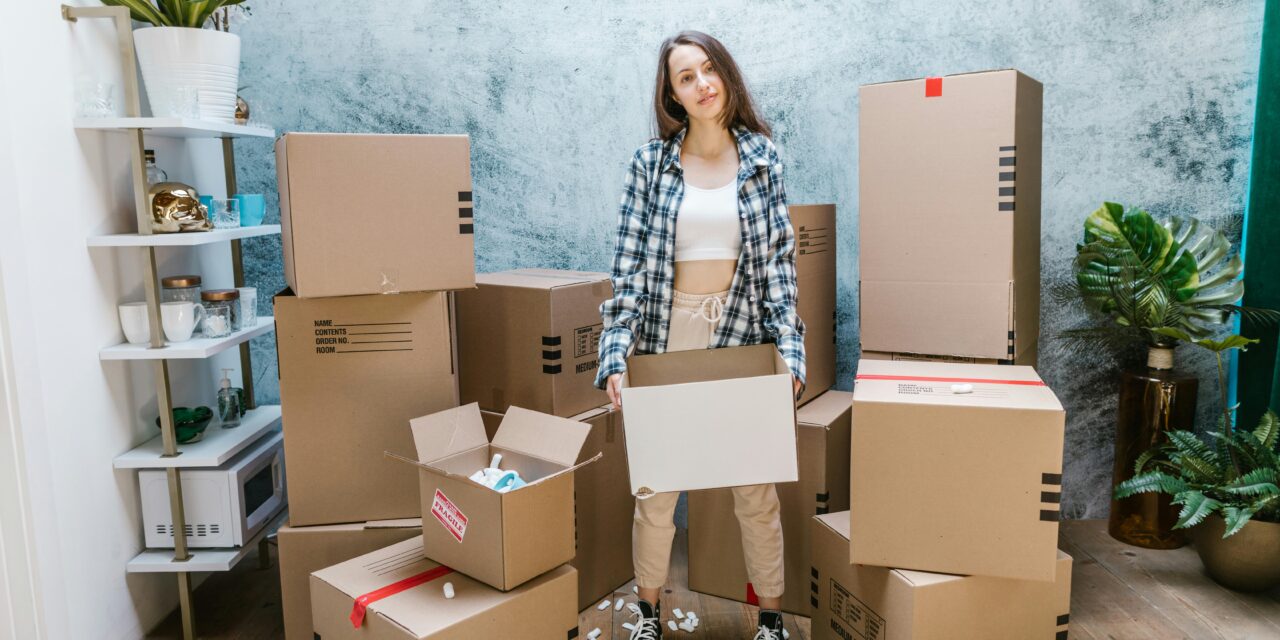When you’re gearing up for a house shift, it’s essential to start early and set a clear timeline to keep everything on track. By decluttering your belongings, you’ll not only simplify packing but also make unpacking a breeze. Crafting a detailed moving checklist and choosing a reliable moving company can save you a lot of headaches down the line. But there are more strategies you might not have considered yet that could enhance your experience even further. Curious about what they are?
Start Early
Starting early is one of the best strategies you can employ when planning a house move. When you give yourself ample time, you reduce stress and create a smoother changeover.
Begin by setting a timeline for your move. Mark key dates, such as when you’ll start packing and when you’ll notify your utility providers. This way, you can tackle each task systematically and avoid last-minute chaos.
Next, consider the logistics of your move. Research and book a moving company that fits your needs well in advance. Look into packing supplies, and don’t hesitate to invest in high-quality materials. They’ll protect your belongings better and save you money in the long run.
As you plan, communicate with your family or housemates. Keeping everyone informed fosters teamwork and guarantees that everyone’s on the same page. This shared effort can lighten the load and make the process more enjoyable.
Lastly, remember to take care of yourself during this busy time. Schedule breaks and don’t hesitate to ask for help. By starting early, you not only set the stage for a successful move but also allow yourself the space to breathe and adjust.
Declutter Your Belongings
As you gear up for your move, decluttering your belongings can greatly lighten your load and make the shift smoother. Start by evaluating each room in your home. Go through your items systematically, asking yourself if you truly need each piece. If you haven’t used it in the last year, it might be time to let it go.
Create three categories: keep, donate, and discard. For items in the keep pile, verify they hold genuine value or utility. The donate pile can include clothes, electronics, or furniture that are still in good condition but no longer serve you. Local charities or shelters often welcome these donations.
Finally, for items that are broken or unusable, dispose of them responsibly.
Don’t hesitate to involve your family in this process. It can be a bonding experience, and they might’ve insights on what to keep or part with.
Create a Moving Checklist
After you’ve decluttered your belongings, the next step is to create a moving checklist that will help keep you organized throughout the entire process. A well-structured checklist not only reduces stress but also guarantees you don’t forget important tasks.
Here’s how to get started:
- List tasks by priority: Identify essential tasks like notifying your utility companies, changing your address, and scheduling your moving date.
- Set deadlines: Give yourself timelines for each task. This will help you stay on track and avoid last-minute panic.
- Include packing specifics: Break down your packing into manageable sections, such as rooms or categories. This makes it easier to tackle and guarantees you don’t overlook anything.
You might feel overwhelmed at first, but having a checklist gives you a clear roadmap. As you complete each item, you’ll feel a sense of accomplishment that propels you forward.
Choose the Right Moving Company
Selecting the right moving company is essential for a smooth changeover to your new home. You want to feel confident that your belongings are in capable hands. Start by doing thorough research; ask friends for recommendations and read online reviews.
Look for companies with a solid track record and positive customer feedback.
Next, obtain quotes from several movers. Be cautious of unusually low prices, as they might indicate hidden fees or subpar service. Confirm that each company provides a detailed breakdown of their charges. This transparency can help you make a more informed decision.
Check that the moving company is licensed and insured. This step protects you against potential damages or losses during the move. If you’re unsure where to start, consider exploring house shifting services from ServiceMarket, which offer verified movers to ensure a hassle-free experience.
Don’t hesitate to ask about their experience with moves similar to yours, especially if you have valuable or fragile items.
Gather Packing Supplies
When you start preparing for your move, gathering packing supplies is an important step that can make the entire process smoother.
Having the right materials on hand not only saves time but also helps protect your belongings during the move. Here are three key items you should consider:
- Boxes: Invest in sturdy, diverse-sized boxes. You’ll need small boxes for heavy items and larger ones for lighter, bulkier items.
- Packing Tape: Strong packing tape is vital for securing your boxes. Make sure to have plenty on hand to avoid any last-minute runs to the store.
- Bubble Wrap or Packing Paper: Protect fragile items with bubble wrap or packing paper. These materials provide cushioning and prevent breakage during transit.
Don’t forget markers for labeling your boxes, as this will save you from confusion later.
Gathering these supplies ahead of time guarantees you’re not scrambling at the last minute, reducing stress as your moving day approaches.
Pack Room by Room
Packing room by room can streamline your moving process and reduce the chaos that often accompanies relocation. By focusing on one space at a time, you’ll keep your packing organized and manageable.
Start with the least-used rooms, like guest bedrooms or storage areas, so you won’t disrupt your daily routine.
As you pack, sort items into categories: keep, donate, and discard. This helps you declutter and only move what you truly need. Remember, it’s easier to pack when you know what you want to take with you.
If you encounter items that spark memories, take a moment to appreciate them before deciding their fate. Emotional attachments can make packing tough, but it’s vital to prioritize functionality in your new space.
Don’t hesitate to enlist help from family or friends. They can provide support and make the process more enjoyable.
Finally, aim to finish one room completely before moving on to the next. This will give you a sense of accomplishment and create a clear path forward as you prepare for your new home.
Embrace the journey, and soon you’ll be settling into your new space with ease!
Label Your Boxes
Once you’ve finished packing each room, it’s time to make sure you can easily identify what’s inside each box.
Labeling your boxes is essential for a smooth moving experience. It saves you time and reduces stress when unpacking in your new home.
Here are three key tips for effective labeling:
- Be Specific: Instead of writing “kitchen,” specify “kitchen utensils” or “dining dishes.” This way, you’ll know exactly what to expect when you open the box.
- Use Color Codes: Assign a color to each room—blue for the bedroom, green for the kitchen, etc. This visual cue not only makes it easier to identify boxes at a glance but also helps movers know where each box belongs.
- Include a Summary: On each box, list the most important items inside. For example, “Living Room – TV remote, books, cushions.” This can save you from rummaging through multiple boxes to find essential items when you arrive.
Notify Important Contacts
Notifying important contacts about your move is a crucial step that shouldn’t be overlooked. Start by updating family and friends so they know how to reach you at your new address. Let them know your moving date; this helps them plan visits or send you well wishes.
Next, inform your employer and coworkers. If you’re changing jobs or your work address, make sure to provide them with your new details. This guarantees there’s no confusion about where to send documents or invitations.
Don’t forget to update your bank, credit card companies, and insurance providers. They need your new address for billing statements and other important correspondence.
Additionally, inform your healthcare providers and any subscription services, like magazines or meal kits, to guarantee your deliveries continue uninterrupted.
Lastly, consider notifying your child’s school or daycare. This helps them update their records and keeps communication flowing smoothly.
Take Care of Utilities
After you’ve informed your important contacts about your move, it’s time to tackle your utilities. Managing your utilities can be a bit overwhelming, but with a little organization, you’ll guarantee a smooth shift.
Here’s what you should prioritize:
- Disconnect Current Services: Contact your electricity, water, gas, internet, and cable providers to schedule a disconnection at your old place. Make sure to do this at least a week in advance to avoid any last-minute issues.
- Set Up New Services: Reach out to the same providers to establish services at your new address. Aim to have everything ready before you move in, so you’ll have a comfortable environment right from day one.
- Transfer or Update Accounts: If you’re staying with the same providers, ask about transferring your account. If you’re switching companies, guarantee you update any necessary information, like billing addresses or contact details.
Plan for Moving Day
As you gear up for the moving day, effective planning can make all the difference in reducing stress and guaranteeing everything goes smoothly.
Start by creating a detailed schedule for the day, including when the movers will arrive and when you plan to leave your old home. Make sure to confirm the moving company’s arrival time a day before, so you’re not left waiting.
Next, pack an essentials bag containing everything you’ll need for the day, such as important documents, medications, snacks, and a change of clothes. This way, you won’t have to rummage through boxes when you need something right away.
Designate a specific area for your movers to load and unload items. Clear pathways in both homes to avoid any accidents or delays.
If you have children or pets, consider arranging for them to stay with friends or family during the move to minimize distractions and guarantee their safety.
Unpack Strategically
While it might be tempting to plunge into unpacking everything at once, taking a strategic approach can make the process much more manageable.
Start by focusing on the essentials first. This way, you’ll quickly create a functional living space, reducing the initial chaos and stress.
Here are three key steps to take into account:
- Prioritize Key Rooms: Unpack the kitchen and bedrooms first. You’ll need these areas for daily living. Having your cooking and sleeping spaces set up will give you a sense of normalcy.
- Unpack in Stages: Instead of tackling everything in one go, break it down. Unpack one room at a time, allowing you to maintain focus and organization. It’s less overwhelming!
- Sort and Organize: As you unpack, take the time to sort items into keep, donate, or discard. This not only helps declutter but also guarantees you only bring what you truly need into your new space.
Conclusion
To wrap up, remember that planning ahead can make all the difference in your house-shifting experience. Did you know that nearly 35% of people find moving to be one of life’s most stressful events? By starting early, decluttering, and following these tips, you can greatly reduce that stress. Embrace the process, stay organized, and focus on the exciting new chapter ahead. You’ve got this, and your smooth changeover is just around the corner!







Recent Comments